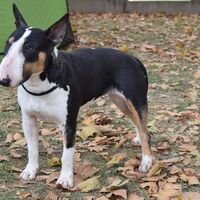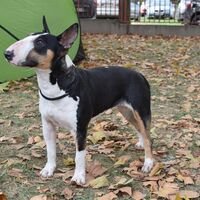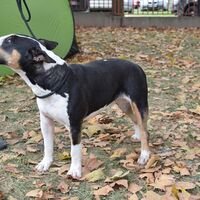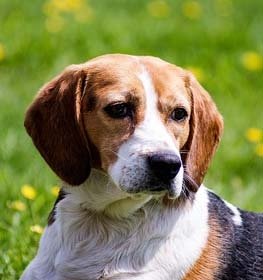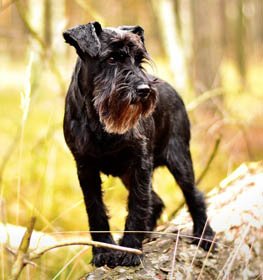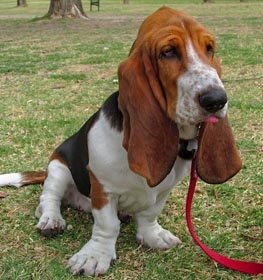Bull Terrier Information & Dog Breed Facts
Collection of all the general dog breed info about Bull Terrier so you can get to know the breed more.
| Group | Hunting Dogs |
|---|---|
| Popularity Rank | 60 |
| Reviews | 7 |
| User Ratings | |
|
Compare the Bull Terrier With Other Dogs
Select at least one dog breed to make the comparsion. | |
 | |
| Origin | |
|
Common Names & Aliases
What other names is a Bull Terrier known by? Discover all traditional, regional and informal names used for this breed. | BullyGladiatorEnglish Bull Terrier |
|---|---|
|
Breed Classification
What type of dog breed is a Bull Terrier? Learn about its genetic classification and breeding category. | Purebred |
Photo Gallery of the Bull Terrier Breed
|
Size Classification
What size category is a Bull Terrier? Learn how big the Bull Terrier breed typically grows. | Medium |
|---|---|
|
Weight Statistics
How much does a Bull Terrier weigh? Discover typical weight ranges for adult males and females of the Bull Terrier breed. | Male: 55-80 pounds (25-36 kg), Female: 45-70 pounds (20-32 kg) |
|
Average Weight
What is the average weight of a Bull Terrier? | Male: 67.5 pounds (30.5 kg), Female: 62.5 pounds (28.5 kg) |
|
Height
How tall is the Bull Terrier? Bull Terrier height: | Male: 22-24 inches (56-60 cm), Female: 20-22 inches (51-56 cm) |
|
Average Height
What is the average height of a Bull Terrier? | Male: 23 inches (58.5 cm), Female: 21 inches (53.5 cm) |
|
Price Range
How much does a Bull Terrier puppy cost? Find current market prices and factors affecting Bull Terrier costs. | $1200-$1500 If you choose to purchase the Bull Terrier, you should know that the mentioned amount of money is an average of the collected data from breeders’ sites and puppy finder places. If you have a Bull Terrier for sale, please advertise it on a reliable website to make sure the Bull Terrier gets to a happy place. |
|---|---|
|
Availability
How easy is it to get a Bull Terrier? How many Bull Terrier are there in the world? | Very frequent: The Bull Terrier is quite easy to get. There is a risk of overbreeding, as it is an extremely popular breed. Inbreeding is common because of its popularity. A new study suggests that inbreeding contributes to the incidence of disease and health problems. So be careful, buy from a trustworthy place or kennel and seek the help of an experienced person, a professional, to make the right decision. |
|
Intelligence Rating
How intelligent is a Bull Terrier? Discover the Bull Terrier's intelligence ranking and learning capabilities. | Smart: The Bull Terrier dogs have great intelligence. They understand and memorize new commands in 15-25 repetitions.
The Bull Terrier is among the smartest dogs in the intelligence ranking. |
|---|---|
|
Training Difficulty
How easy is it to train a Bull Terrier? Learn about the Bull Terrier's trainability and response to training methods. | Bull Terrier dogs are easy to train. They find out the association between commands and actions quite quickly. |
|
Watchdog Rating
How good is a Bull Terrier as a watchdog? Learn about the Bull Terrier's alertness and guarding instincts. | Bull Terrier dogs are one of the best watchdogs. Their main job is to observe and they're very consistent in their effort. The best vocal cords and sense of hearing belong to them. Usually, they're very territorial and protective about their property, so the Bull Terrier dogs will alert you if they sense something different. |
|
Territorial Protection
Is a Bull Terrier protective of its territory? Learn about the Bull Terrier's guarding instincts and behavior. | Bull Terrier dogs are extremely protective guard dogs. This breed doesn't hesitate to protect its territory so the Bull Terrier can be a good choice if you want an excellent guard dog. Keep calm and the Bull Terrier will take care of unwanted people or animals. |
|
Personality Traits
What personality does a Bull Terrier have? Learn about characteristic Bull Terrier temperament and behavior traits. | ActiveProtectiveTemperedSweetTrainableKeen |
|---|---|
|
Sensitivity Level
How sensitive are they? Bull Terrier sensitivity: | Sensitive: Bull Terrier dogs don't like an irregular daily routine, noisy household, and frequent guest visits.
This breed's emotional level reflects their owner's feelings and they don't handle punishments well. |
|
Affection Level
How affectionate are they? Is a Bull Terrier a good family dog? | Average to High: Bull Terrier dogs are highly affectionate dogs. They like being involved in the family's life. This breed isn't considered an aloof dog. |
|
Social Needs
How much social interaction does the Bully need? Bull Terrier social needs: | Bull Terrier dogs need a lot of social interaction. They desire to always be with someone or around people. This breed hates being left alone. |
|
Impulse to Wander or Roam
How likely is the Bull Terrier to run away? Does this breed explore or wander a lot? Does Bull Terrier roam? | Bull Terrier dogs have high wanderlust potential, which means that this breed has a strong desire for exploring the world. Safer to walk them on a leash unless you teach them how to get back to you on command. This breed is also able to cause damage to your fence. |
|
Prey Drive
Do this canine have a strong prey drive? Does Bull Terrier have high prey drive? | Bull Terrier dogs have a higher impulse to chase and catch something than other dog breeds. Cats or any other small animals might be in danger. It's a natural instinct, doesn't necessarily mean that Bull Terrier dogs are aggressive. Better to keep this breed on a leash. |
|
Barking Frequency
Does a Bull Terrier bark a lot? Learn about typical Bull Terrier vocalization patterns and triggers. | Low to Average: The Bull Terrier rarely barks. This breed could be a good choice if you're looking for a quiet breed. They don't bark unless there is a good reason.
Top reasons for barking: protection, alarm, fear, boredom, attention-seeking, greeting, separation anxiety, compulsive barking. |
|---|---|
|
Playful Nature
How playful is a Bull Terrier? Understand the typical play drive and energy level of the Bull Terrier breed. | The Bull Terrier is a highly playful breed. Excited barking and sometimes nipping will alert you to play. |
|
Apartment Adaptability
Can a Bull Terrier live in an apartment? Learn about the Bull Terrier's suitability for apartment living. | Apartment-friendly dog the Bull Terrier breed. It is best if you have a small garden where it can occasionally go out to do its business, but this is not important at all. You can exercise him enough with a walk or two a day, so he's comfortable in an apartment. |
|
Lifestyle Adaptability
How adaptable is a Bull Terrier to lifestyle changes? Learn about the Bull Terrier's flexibility to new situations. | Bull Terrier dogs adapt well to lifestyle changes and different living environments. They don't mind moving from one place to another with their owner. |
|---|---|
|
Alone Time Tolerance
Can a Bull Terrier be left alone? Learn about the Bull Terrier's tolerance to solitude. | Bull Terrier dogs tend to have separation anxiety when their owners left them alone at home because they bond very closely with them. |
|
Bite Risk Assessment
What is a Bull Terrier biting potential? Learn about the Bull Terrier's bite risk factors. | Low 🔽 The Bull Terrier has a low chance of biting somebody. Top reasons for dog bite: protection, pain, excitement, herding instinct, being provoked. (Data based on the available online bite statistics.) |
|---|---|
|
Mouthing Tendency
Is a Bull Terrier mouthy? Learn about the Bull Terrier's tendency to use mouth during play. | Bull Terrier dogs have a higher than average tendency to nip, chew, playbite, or herd people. It's a common habit during puppyhood, not aggressive behavior. These "bites" don't hurt, but Bull Terrier dogs need to be taught a good attitude. |
|
Bite Strength Rating
How strong is a Bull Terrier bite? Learn about the Bull Terrier's bite force measured in PSI. | Between 200 and 400 PSI ⏺ Bull Terrier bite force: Ordinary. Bite force Bull Terrier measurements typically fall within the range of 200 to 400 PSI. The bite force of a Bull Terrier is considered ordinary when compared to other dog breeds, but it is still quite powerful. This Bull Terrier bite force PSI can cause bite wounds. Bull Terrier bite PSI is not something that should be feared if the dog is well-trained and managed. To avoid any issues, it's essential to learn how to train a Bull Terrier puppy not to bite from an early age.
The Bull Terrier, and many others, have a fearsome presence because they have significant jaw strength, so it is important not to anger the dog and have it around strangers until it is fully trained. However, they are usually quite calm and good companions, they work well in families and are easy to care for. In conclusion, while the Bull Terrier bite force is certainly an interesting aspect of the breed, it is important not to let it overshadow the many other reasons why these dogs are so loved and respected. With proper training and socialization, a Bull Terrier can be a loyal and protective companion for your family. |
|
Average Lifespan
How long does a Bull Terrier live? Learn about the typical lifespan of the Bull Terrier breed. | 10-12 years The average lifespan of Bull Terrier: 11 years |
|---|---|
|
Climate Tolerance
How well does a Bull Terrier handle different weather? Learn about the Bull Terrier's climate adaptability. | Prefers warm weather Dogs that prefer warm weather conditions are typically breeds that were originally bred in warmer climates. |
|
Health Concerns
What health issues are common in a Bull Terrier? Discover typical conditions affecting the Bull Terrier breed. | Very healthy dog breed. The Bull Terrier rarely meets with the veterinarian. |
|
Vet Care Frequency
How often does a Bull Terrier need vet visits? Learn about the Bull Terrier's veterinary care requirements. | Rare The Bull Terrier should have a complete physical check-up at least every 12-18 months (but preferably once per year). If your dog shows any symptoms, call your veterinarian. |
|
Health Problems
What genetic/health problems does the Bull Terrier breed have? What are the health issues and concerns of the Bull Terrier breed? Most common health risks of Bull Terrier: | Heart MurmursDeafnessHereditary NephritisLens LuxationSpinning |
|
Energy Rating
How energetic is a Bull Terrier? Understand daily activity needs of the Bull Terrier breed. | Bull Terrier dogs have a higher energy level than other dog breeds. If you want a dog for snuggling on the couch, this breed isn't the perfect choice for you. |
|---|---|
|
Activity Requirement / Exercise Need
How much exercise does a Bull Terrier need? How much exercise do Bull Terrier dogs require per day?
Do Bull Terrier dogs need a lot of exercises? | Bull Terrier dogs need quite a lot of exercise. Daily walks should be on schedule. If you live an active life, this breed can be a good choice for you. |
|
Sleeping Need
How much sleep does the Bull Terrier breed need? | Bull Terrier dogs are quite energetic dogs and they don't spend too much time with sleeping. If you live an active life, this breed can be a good choice for you. |
|
Obesity Tendency
Is a Bull Terrier prone to weight gain? Learn about the Bull Terrier's obesity risks. | High: The Bull Terrier breed has a strong tendency to be overweight. Try to find the happy medium between exercise and feeding. If you want to keep balance, increase the amount and frequency of your daily dog walk and play with the Bull Terrier more often.
If you notice any weight gain, consult your veterinarian and make a diet plan. Reduce unhealthy food and snacks, and measure the Bull Terrier weight regularly. |
|---|---|
|
Food Consumption
How much food does a Bull Terrier need daily? Learn about the Bull Terrier's feeding requirements. | 2.5 to 3.5 cups of a high-quality dog food daily, divided into two meals. |
|
Allergy Friendliness
Is a Bull Terrier hypoallergenic? Learn about the Bull Terrier's suitability for allergy sufferers. | No Bull Terrier dogs don't do well with allergy sufferers by causing allergic reactions. Some dog breeds are even considered to higher possibility of an allergic response. Coat type isn't necessarily relevant, because most people are allergic to dander (flakes on the dog's skin) or saliva, not actually to dog hair. |
|---|---|
|
Coat Colors
What colors does a Bull Terrier come in? Discover all possible Bull Terrier color variations. | Black White Brown Brindle Tricolor |
|
Grooming Requirements
How much grooming does a Bull Terrier need? Learn about Bull Terrier coat maintenance requirements. | Effortless: The Bull Terrier requires minimal grooming. Seasonal flea treatment is needed, but cutting the dog's hair by a professional groomer isn't necessary. Ears and eyes should be cleaned sometimes to avoid infections. Bull Terrier is one of the best choices if you don't have the time, skill, or money to take care of a high-maintenance dog. Highly recommended for beginners. |
|
Drooling Tendency
Does a Bull Terrier drool a lot? Learn about the Bull Terrier's drooling habits. | The Bull Terrier is a perfect example of a very low drooling tendency. If you're disgusted by slobber spots on your clothes, the Bull Terrier could be a perfect choice for you. Drooling is the unintentional saliva flowing outside of the mouth. It can be completely normal or a sign of a health problem. Certain dog breeds drool minimum compared to others, just like the Bull Terrier.
If you notice any change in your dog's drooling habit, you should contact a vet as soon as possible. |
|
Stinkiness Rating
Does a Bull Terrier smell bad? Learn about the Bull Terrier's natural odor levels. | Medium ⏺ The Bull Terrier has an average chance of bad smell. Top reasons for dog stinkiness: infection of bad tooth/ear/skin folds, gas attacks. |
|
Coat Characteristics
What type of coat does a Bull Terrier have? Learn about the Bull Terrier's fur characteristics. | DenseSmooth |
|
Bathing Needs
How often does a Bull Terrier need baths? Learn about the Bull Terrier's bathing requirements. | 4-6 weeks Average. Experts recommended at least every 4-6 weeks for this family pup. According to a study, 56% of pet parents don’t bathe their dogs as frequently as they should, and 60% use the sniff test when deciding when it’s bath time.
Bathing your dog is beneficial to them in more ways than just one. It’s also a good time to look for unusual scratches, bumps, fleas, and other irregularities. When their hair is wet and flat against their body, these details are more visible. |
|
Shedding Level
How much do Bull Terrier dogs shed? How to control, reduce and prevent the shedding of the Bully? Do Bull Terrier dogs shed a lot? | Bull Terrier dogs shed moderately. It's a natural process of the hair growth cycle. Regular brushing reduces the amount of hair that sheds. It mostly depends on their health status and breed type. |
|
Child Compatibility
Is a Bull Terrier good with children? Learn about the Bull Terrier's behavior around kids of different ages. | Bull Terrier dogs are kid-friendly dogs. This breed is a good choice if you have children. |
|---|---|
|
Pet Compatibility
How well does a Bull Terrier get along with other pets? Discover the Bull Terrier's compatibility with other animals. | Bull Terrier dogs usually don’t get on well with other pets. |
|
Stranger Friendly
Are they aggressive or friendly towards/with strangers? Bull Terrier temperament with other people: | Bull Terrier dogs are stranger-friendly dogs. |
|
Cat Friendly
How well do Bull Terrier dogs get along with cats? Are they good with kittens? What is this fido's temperament with cats? Can they be good with cats? Can the Bull Terrier breed live with a cat? | Bull Terrier dogs are not the most cat-friendly dogs. |
|
Dog Friendly
Is Bull Terrier good with other dogs? Are they dog-friendly dogs? How well do Bull Terrier dogs get along with other dogs? | Bull Terrier dogs are not the most dog-friendly dogs. If you want more dogs in your family or you'd like to join dog meetups, the Bull Terrier is not a good choice. |
|
Good For First Time Owners
Is Bull Terrier breed good for first-time owners? Do they make a good dog for novice owners? Is Bull Terrier breed suitable for first-time owners? | Yes Bull Terrier dogs are good for novice owners, due to their easy-going personality. |
|
Office Friendly
Are Bull Terrier dogs good office canines? Do Bull Terrier dogs make good office-friendly pets? Can they be office dogs? | No Bull Terrier is not the best dog breed for office environment. |
|
Senior Citizens Friendly
Are they senior citizens friendly dogs? How well do Bull Terrier dogs get along with the elderly people? What is the Bully temperament with senior people? Are Bull Terrier dogs good for elderly owners? | Bull Terriers are usually recommended for elderly people. |
|
Service Dog Capability
Can a Bull Terrier be a service dog? Learn about the Bull Terrier's service work potential. | Not really This breed generally not used as a service dog. A service dog is a term used in the USA to refer to any type of assistance dog specifically trained to help people who have disabilities, such as visual impairment, hearing impairments, mental disorders, seizures, mobility impairment, and diabetes. Service dogs are protected under the ADA (Americans with Disabilities Act).
Bull Terrier is not the best breed for service purposes. |
|---|---|
|
Therapy Work Suitability
Is a Bull Terrier good as a therapy dog? Learn about the Bull Terrier's therapy work aptitude. | Not really This breed is generally not used as a therapy dog. A therapy dog is a dog that might be trained to provide affection, comfort, and love to people in hospitals, retirement homes, nursing homes, schools, hospices, disaster areas, and people with anxiety disorders or autism.
Bull Terrier is not the best breed for therapeutic purposes. |
|
Scent Detection Ability
Is a Bull Terrier good at detection work? Learn about the Bull Terrier's scenting abilities. | Not really They are not typically employed for this type of work, but there may be exceptional cases. A detection dog or sniffer dog is a dog that is trained to use its senses (mostly its smell) to detect substances such as explosives, illegal drugs, wildlife scat, currency, blood, and contraband electronics such as illicit mobile phones.
Bull Terrier is not the best breed for detection purposes. |
|
Search & Rescue Potential
Can a Bull Terrier do search and rescue? Learn about the Bull Terrier's SAR capabilities. | Not really This dog breed is not typically used as a search and rescue dog. The use of dogs in search and rescue (SAR) is a valuable component in wilderness tracking, natural disasters, mass casualty events, and locating missing people.
The Bull Terrier is not the best breed for SAR purposes. |
|
Maritime Work Ability
Is a Bull Terrier good on boats? Learn about the Bull Terrier's maritime capabilities. | Not really Bull Terrier breed usually doesn't like being on a boat. Boat dogs were typically bred for their strength, stamina, and water resistance, as they were often required to perform tasks such as pulling in fishing nets, and jumping into the water to retrieve ropes or lines, or helping to move cargo. Sailor dog is a type of dog that was bred to accompany sailors on their voyages. They were typically used for three purposes: as a working dog, a watchdog, and as a companion. A boat dog is a term used to describe a type of dog that was traditionally bred and used as a working dog on boats. |
|
Draft Work Capability
Can a Bull Terrier pull carts? Learn about the Bull Terrier's drafting abilities. | Not really A drafting dog or draft dog is a dog bred and used for cart pulling. Dogs bred for this work have strong builds and qualities that are needed, strength and determination.
Bull Terrier is not the best breed for drafting purposes. |
|
Military Service Background
Was a Bull Terrier used in military service? Learn about the Bull Terrier's military history. | Yes In history, this breed was unfortunately used for combat dogs. A combat dog is a specially trained dog that is used in warfare to help protect military personnel and assets. Combat dogs are often deployed in areas where there is potential for contact with the enemy, such as during raids or search operations.
Combat dogs are typically assigned to either infantry or special operations units. They are used for a variety of tasks including area security, sentry duty, trackers, and explosive detection. In addition to their combat roles, combat dogs also play an important role in troop morale by providing companionship and emotional support. |
|
Puppy Litter Size
How many puppies does a Bull Terrier usually have? Learn about typical litter sizes. | 1-9 puppies, average 5 |
|---|---|
|
Pregnancy Duration
How long is a Bull Terrier pregnant? Learn about the Bull Terrier's gestation period. | 60-64 days Reproductive cycle of the female Bull Terrier: The first period called Proestrus lasts for about 9 days.
During this time the females start to attract males. You can notice by swelling vulva and bloody discharge. The second part is the Estrus when the female is receptive for the male. It lasts for about 3 to 11 days. The sign of the proestrus part is the soft and enlarged vulva. The discharge decreases and lightens in color. The third part is the Diestrus. Normally, it occurs around day 14. In this period the female’s discharge changes for vivid red and coming to its end. The vulva returns to average, and she will no longer permit mating. The fourth part called the Anestrus. The time frame between heat periods normally lasts about six months. |
|
Breeding Frequency
How often can a Bull Terrier have puppies? Learn about safe breeding intervals. | Once a year. More frequent breeding is not healthy. It is very important not to buy a dog from a puppy mill, where the needs of the pups and their mothers are ignored. It's an inhumane high-volume dog breeding facility, where puppies born several times a year. |
|
AKC Classification
What AKC group is a Bull Terrier in? Learn about the Bull Terrier's AKC classification. | Recognized by the American Kennel Club in 1885 as a Terrier breed. |
|---|---|
|
FCI Classification
What FCI group is a Bull Terrier in? Learn about the Bull Terrier's international classification. | Recognized by FCI in the Terriers group, in the Bull type Terriers section. |
|
Kennel Club Recognition
Which kennel clubs recognize a Bull Terrier? Learn about the Bull Terrier's official recognition. | American Canine RegistryAmerican Kennel ClubAmerica's Pet RegistryCanadian Kennel ClubDog Registry of America Inc.Federation Cynologique InternationaleKennel Club of Great BritainNorth American Purebred Registry, Inc.American Canine Association, Inc.Australian National Kennel CouncilContinental Kennel ClubNational Kennel ClubNew Zealand Kennel ClubUnited Kennel Club |
Bull Terrier Pros and Cons
- Intelligence Rating: Smart: The Bull Terrier dogs have great intelligence.
- Training Difficulty: Bull Terrier dogs are easy to train.
- Health Concerns: Very healthy dog breed.
- Apartment Adaptability: Apartment-friendly dog the Bull Terrier breed.
- Grooming Requirements: Effortless: The Bull Terrier requires minimal grooming.
- Drooling Tendency: The Bull Terrier is a perfect example of a very low drooling tendency.
- Watchdog Rating: Bull Terrier dogs are one of the best watchdogs.
- Lifestyle Adaptability: Bull Terrier dogs adapt well to lifestyle changes and different living environments.
- Child Compatibility: Bull Terrier dogs are kid-friendly dogs.
- Senior Citizens Friendly: Bull Terriers are usually recommended for elderly people.
- Good For First Time Owners: Bull Terrier dogs are good for novice owners, due to their easy-going personality.
- Allergy Friendliness: Bull Terrier dogs don't do well with allergy sufferers by causing allergic reactions.
- Obesity Tendency: High: The Bull Terrier breed has a strong tendency to be overweight.
- Mouthing Tendency: Bull Terrier dogs have a higher than average tendency to nip, chew, playbite, or herd people.
- Impulse to Wander or Roam: Bull Terrier dogs have high wanderlust potential, which means that this breed has a strong desire for exploring the world.
- Alone Time Tolerance: Bull Terrier dogs tend to have separation anxiety when their owners left them alone at home because they bond very closely with them.
- Cat Friendly: Bull Terrier dogs are not the most cat-friendly dogs.
- Dog Friendly: Bull Terrier dogs are not the most dog-friendly dogs.
- Office Friendly: Bull Terrier is not the best dog breed for office environment.
Bull Terrier History
Bull Terrier Origins & History
The Bull Terrier came into being by the crossing of a now-extinct white English White Terrier and a Bulldog approximately in 1835. The crossing of these ‘bull and terrier’ dogs and the Dalmatian resulted in the formation of the Bull Terrier. The breeders’ purpose was to create the best, the strongest-boned fighting dog breed since dog fighting was an extremely popular spectacle in the 18th century in England. For fifty years, until the dog-fightings were banned, their ears were fully cut off since they believed that these cannot be injured while fighting.
The systematic breeding of the Bull Terrier began around 1850 and can be associated with the name of a pet dealer James Hinks, who lived in Birmingham. In contrast to the previous approach, primarily he did not consider them as fighting dogs, rather as fashionable companion dogs. From the beginning, Hinks brought his own Bull Terriers to exhibitions since one of his aims was to rear a formally proper dog breed. The nickname of the Bull Terriers was ‘White Cavalier’ because of their courtliness toward people. These brave and fast dogs were also used for grubbing up rats.
The breed gained its popularity through brutal dog-fighting shows in the 18th and 19th centuries. Thanks to these shows, Bull Terriers seemed to be aggressive and snappy with their indefatigable nature. In spite of the belief, bull terriers are rather friendly and obedient dogs. However, in 1835, when dog-fightings were banned, was too late, people believed they are ruthless agonistic dogs.
The first Bull Terrier registered by the American Kennel Club (AKC) was Nellie II in 1885. Two years later the ‘New Bull Terrier’ gained in popularity. In 1897, the Bull Terrier Club of America was formed.
One of the most well-known Bull Terriers was Patsy Ann, who greeted each ship that docked in Juneau, Alaska during the 1930s. Today, her spirit lives on in a bronze statue that was placed on the Juneau wharf in 1992.
A colored Bull Terrier, Rufus, made history in 2006 when he became the first colored Bull Terrier to win Best in Show at the Westminster Kennel Club dog show. The only white Bull Terrier to win the prestigious event was Ch. Haymarket Faultless in 1918. The breed's appearance has changed quite a bit since then.
Latest Bull Terrier Compares
Bull Terrier Names
How old is my Bull Terrier in human years?
You May Also Like
Rate The Bull Terrier Breed
Bull Terrier Comments, Reviews and Questions
- maya
Jan 3, 2025, 10:08:52 AM:
Amazing dog breeeds. I have one called Ella who is a cutie. So amazing.
- Luka
Mar 3, 2023, 5:21:02 PM:
Bonk
- Luka
Feb 14, 2023, 4:39:19 PM:
What the dog doin Yeah they cute and friendly I like terriers
- Wessel
Apr 21, 2022, 7:53:27 AM:
This breed gets way too much praise from their community, perhaps because they want to justify their own terrible dog breed choice or they are insanely active with 4 hours to dedicate daily to training and exercise. Jealous, sensitive dogs.
- David
Apr 19, 2021, 2:31:50 PM:
Its Walter!!!!!!!!!!!
- J
Feb 12, 2021, 5:16:17 PM:
- Bullterier
Dec 9, 2020, 8:38:38 PM:
Have lived my whole 20 years of life with two bull terriers by side and couldn't have had better companions.

